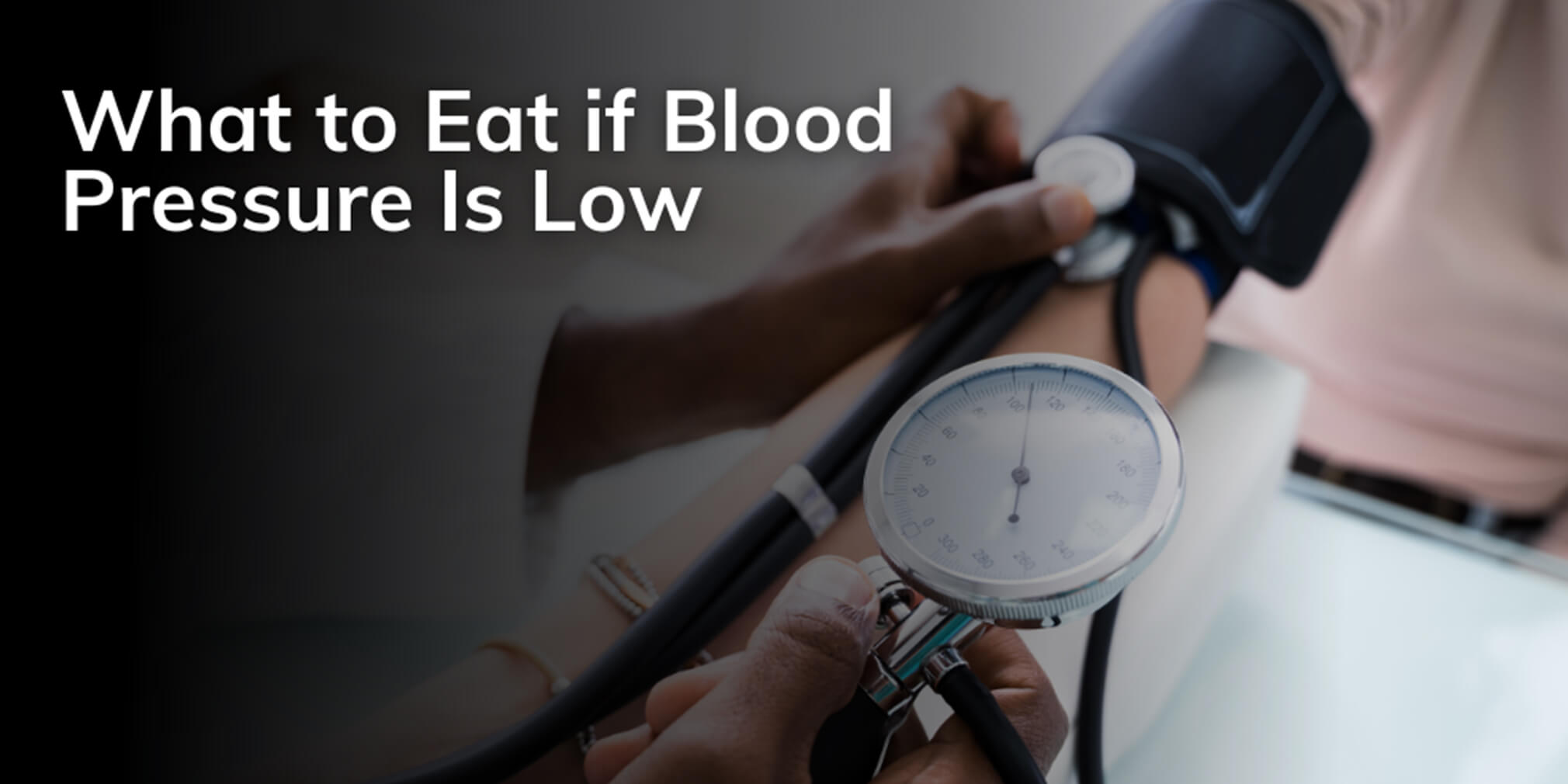
What to Eat if Blood Pressure Is Low
The sudden rush of lightheadedness or a dizzy spell that occurs when people stand up is a familiar and unsettling experience for those with low blood pressure. Yes, this is one of its symptoms or that of hypotension (a condition that can leave people fatigued, weak, or even disoriented).
Indeed, high blood pressure catches all the headlines. Yet its lesser-known counterpart, low blood pressure, is not only as dangerous as the former but also disruptive to an individual’s daily life.
A Steady Blood Flow helps the Human Body Function Properly
The human body indeed requires a steady flow of blood to function correctly. When that pressure drops, vital organs can be temporarily deprived of oxygen (including the brain). This can impact everything from the ability to focus properly to overall energy levels.
Fortunately, managing reduced blood pressure is no longer an arduous task. It also does not require any drastic changes. A quick and straightforward solution often lies in the kitchen. Changing what an individual can eat is an effective and natural way of stabilizing blood pressure. It also alleviates symptoms of reduced blood pressure.
Hence, there is no need to worry about what to eat if blood pressure is low. Incorporating the correct beverages and food items can provide individuals with the required boost. It also helps maintain a consistent and healthy routine throughout the day.
This article will help people go through a list of essentials that can help combat hypotension and keep them energized.
Briefly understanding Low Blood Pressure
Two key readings represent blood pressure. The first number represents the systolic pressure, which is usually higher. It measures the pressure in the arteries when the heart beats and fills them with blood. The second number is diastolic pressure, i.e., pressure in the arteries when the heart is at rest between heartbeats.
The normal blood tension reading in a healthy person is 120/80 mmHg. Reduced blood impulse is defined as a sudden drop, i.e., below 90/60 mmHg. This kind of blood impulse can reduce the volume of blood due to vasoconstriction.
There are two main kinds of less blood tension: primary and secondary hypotension. Let us examine them briefly as follows:
- Primary hypotension occurs in individuals with a special nature, i.e. where the blood pressure remains low from childhood to adulthood, without any complications or symptoms
- Secondary hypotension refers to a condition in individuals where the blood pressure is normal at first. Then it gradually drops to levels known as reduced blood tension.
The lowest blood pressure indicates the blood isn’t circulating efficiently. This results in inadequate nutrient and oxygen delivery to vital organs. Some people naturally have reduced levels of blood pressure without issues. However, some may experience the following issues:
Dizziness or lightheadedness
- Blurred vision
- Fainting episodes
- Nausea
- Trouble concentrating
- Weakness (fatigue)
Many people wonder what to eat if their blood sugar is low despite the occurrence of such symptoms. Adjusting the diet can be an effective natural remedy to reduce blood tension fluctuations. It also helps stabilize energy levels.
What to do when BP is low?
Reduced blood impulse is often observed in individuals who either eat relatively less, skip their meals, or have significant gaps between meals. These habits can cause a decrease in blood sugar levels. Moreover, they reduce the elasticity and flexibility of blood vessels, resulting in a drop in blood impulse.
An individual’s diet and dietary habits play a key role in managing reduced blood impulse. They also help maintain normal levels. Hence, before people determine what to eat if their blood tension is low, they must make a diet plan. Those with low blood tension should understand what to eat, drink, and what to avoid to prevent their condition from worsening.
What to Eat if Blood Pressure is low?
There are food items that are desirable for individuals with reduced blood impulse. These foods help maintain the blood tension at an optimum level. They are also quite handy when individuals are feeling dizzy or experiencing nausea. The following food items answer the query ‘what to eat if blood impulse level is low’:
- Raisins are an excellent & natural low blood pressure treatment food. They support the adrenal gland’s proper functions. The best time to eat them is in the morning on an empty stomach
- Liquorice root helps normalize lower blood impulse that is caused by low cortisol levels in the blood
- Salts having sodium, especially sodium chloride (NaCl), can be added to water. Only a pinch is needed to help raise the blood tension. However, it should not be overused
- Lemon water helps improve the condition caused by dehydration. The antioxidants in lemon help regulate blood circulation to maintain a stable blood impulse
- Almonds are not to be eaten whole. Instead, soak four to five of them overnight, peel their skins off, and then grind them into a paste. Then mix it with a glass of warm milk to drink in the morning to help improve blood tension
- Caffeinated beverages, especially coffee, cola, hot chocolate, and strong tea, can raise the blood pressure temporarily
- Foods rich in iron, especially eggs, fish, liver, milk, jute mallow (leaves and young fruit), lean meats, legumes, pomegranates, shrimp, spinach, and sweet potatoes.
What to avoid when Blood Pressure is low?
Certain food items are not desirable for individuals having low blood tension. We will now briefly examine them:
- Rose apples are beneficial for those with high blood tension. But for individuals having low BP, it is not recommended
- Roasted chestnuts and royal jelly are both helpful in reducing blood tension. Individuals with low BP cannot consume them at any cost
- Carrots contain succinic acid. It raises potassium count in urine and reduces blood tension. It’s best to avoid consuming them in large quantities
- Both bitter melon and tomatoes can reduce the pressure of the blood. Individuals with low levels of such should avoid consuming them in large amounts, as they can suffer from symptoms such as headaches, dizziness, and vertigo
- Cold foods like celery, cucumbers, green beans, onions, red beans, seaweed, spinach, sunflower seeds, and watermelon can reduce blood tension
- Alcoholic beverages, particularly beer, can temporarily raise blood tension due to their effect on the heartbeat rate. They, however, cause dehydration, and blood vessels can dilate. This ultimately causes its levels to drop significantly.
Low BP in Pregnancy what to Eat?
When women are dealing with low blood pressure during pregnancy, it is essential to focus on both a proper diet and a proper hydration routine to manage the symptoms effectively. It is wise to consult a physician before making dietary changes, especially when it comes to the intake of caffeine and salt.
Here are proven tips for managing low blood tension during pregnancy:
- Staying properly hydrated: Dehydration is a common cause of reduced pressure of blood. Drinking plenty of water and fresh fruit juices can help counter dehydration
- Eating small yet frequent meals: Consuming five to six smaller yet balanced meals over three large meals works. It prevents the blood impulse from dropping. That drop is likely to occur after heavy meals
- Increasing intake of salt: This should be done with a physician’s approval, as excessive salt is discouraged. A moderate increase can help raise blood tension in pregnant women
- Taking vitamin B: Deficiencies in folate (B9) and vitamin B12 can contribute to lower blood tension. It is wise to have asparagus, beans, leafy greens, and lentils, along with vitamin B12-rich foods, especially eggs, fish, and fortified cereals. They help maintain a healthy blood tension
- Consuming caffeine in moderation: A small amount of caffeine from either coffee or tea can help raise the blood tension temporarily. But caffeine intake needs to be limited during pregnancy. It should only be done with a physician’s consent.
Fruits for Low Blood Pressure
Fruits are an excellent source of hydration, but nutrients like folate and iron can reduce pressure of blood. However, some can provide nutrients to help maintain its levels at sustainable levels and support hydration. For those wondering what to eat if blood tension is low, especially fruits, then they are in luck right here:
- Apricots: They contain folate and iron that combat anemia and support fetal development.
- Berries: They are rich in antioxidants and also contain vitamin C and fiber. They boost overall health and hydration.
- Citrus fruits: Lemons, oranges, and grapefruits are high in vitamin C and folate. This can prevent anemia (a cause of low blood tension).
- Dry fruits: Dried apricots, dried figs, and raisins have iron. They help with regulating pressure of blood.
Over to You
What to eat when blood tension is low? The answer is right in front of you: Foods rich in vitamin B9 and B12, citrus fruits, apricots, fish, eggs, berries, beans, lentils, leafy greens, fortified cereals, and fruit juices. These foods help regulate pressure of blood, provide the needed nutrients, and maintain hydration. Water is also essential.
Before making any dietary changes, experts recommend consulting a physician to ensure they are safe. It helps determine the proper diet (especially for pregnant women) to prevent adverse effects.
